仁爱版英语九年级下Unit 5 China and the world语法复习课件(21张PPT无素材)
文档属性
| 名称 | 仁爱版英语九年级下Unit 5 China and the world语法复习课件(21张PPT无素材) | 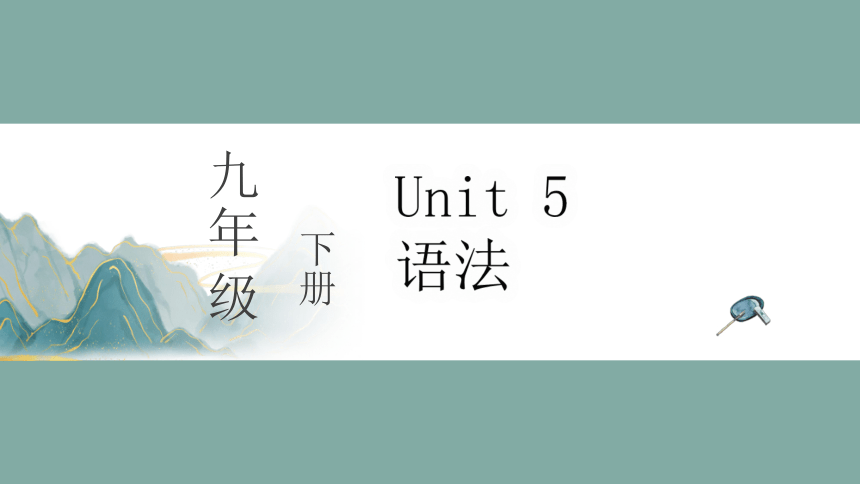 | |
| 格式 | zip | ||
| 文件大小 | 7.8MB | ||
| 资源类型 | 教案 | ||
| 版本资源 | 仁爱科普版 | ||
| 科目 | 英语 | ||
| 更新时间 | 2020-06-11 23:43:03 | ||
图片预览

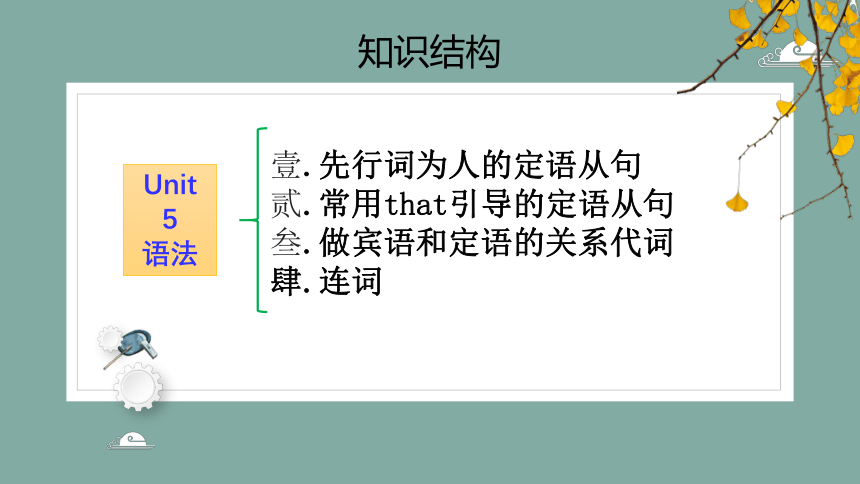
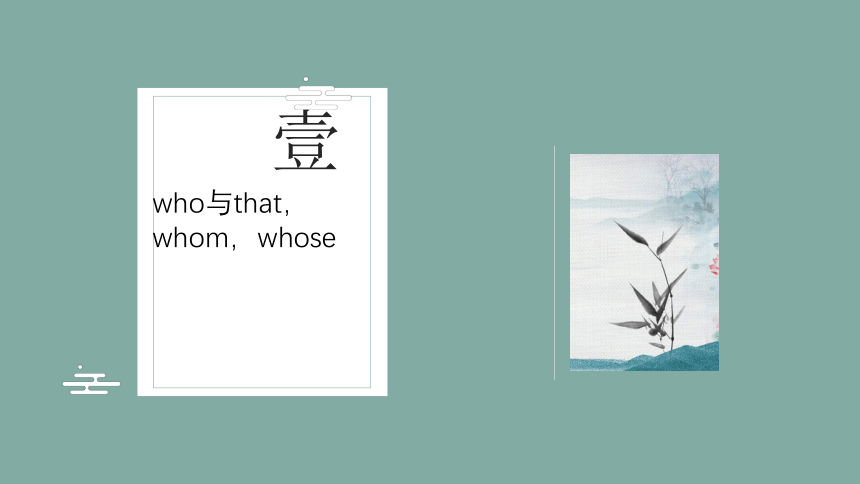
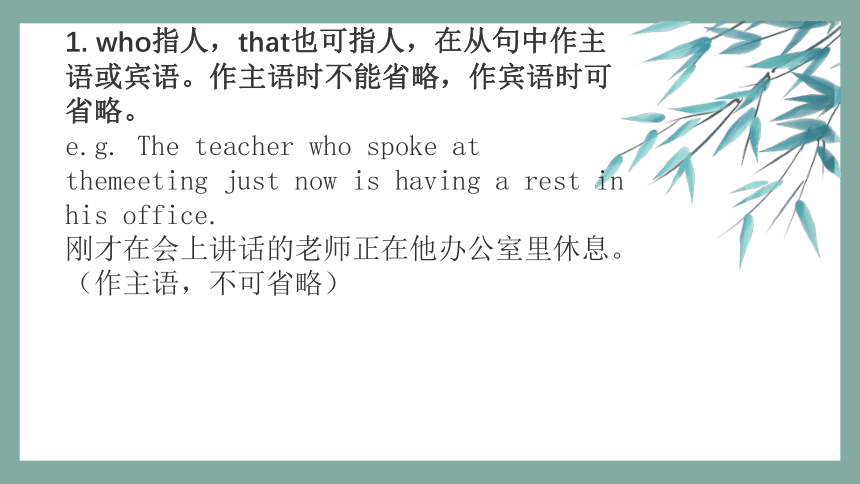
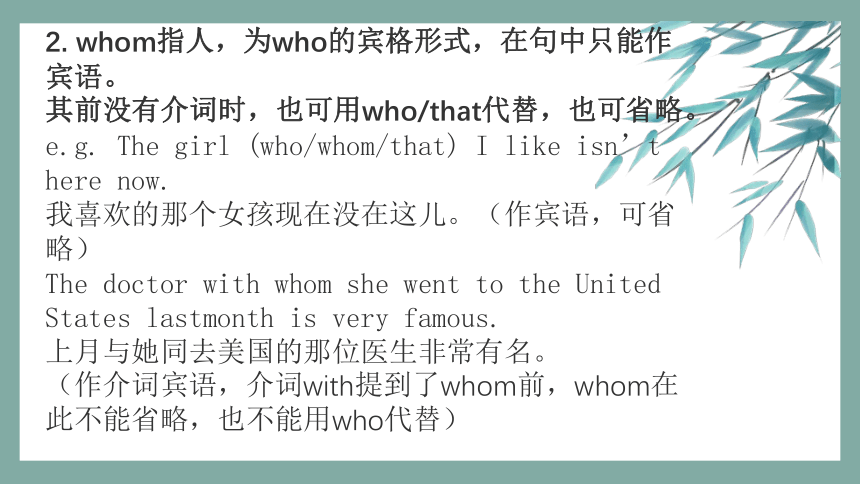
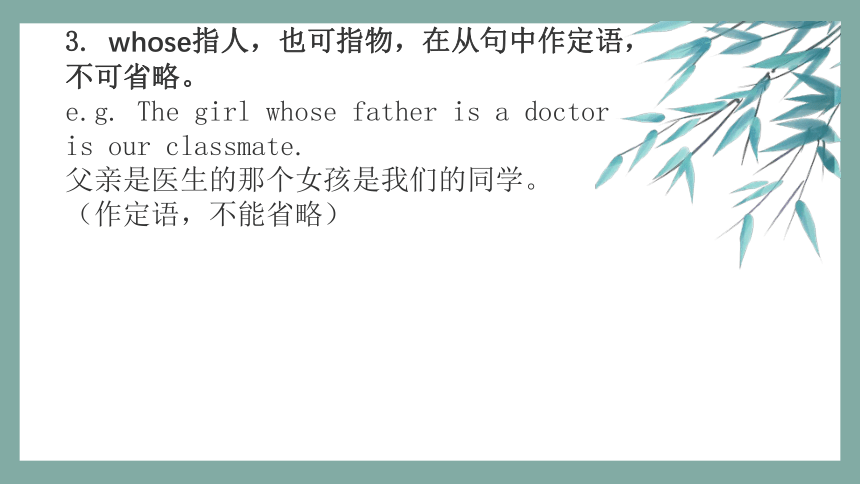
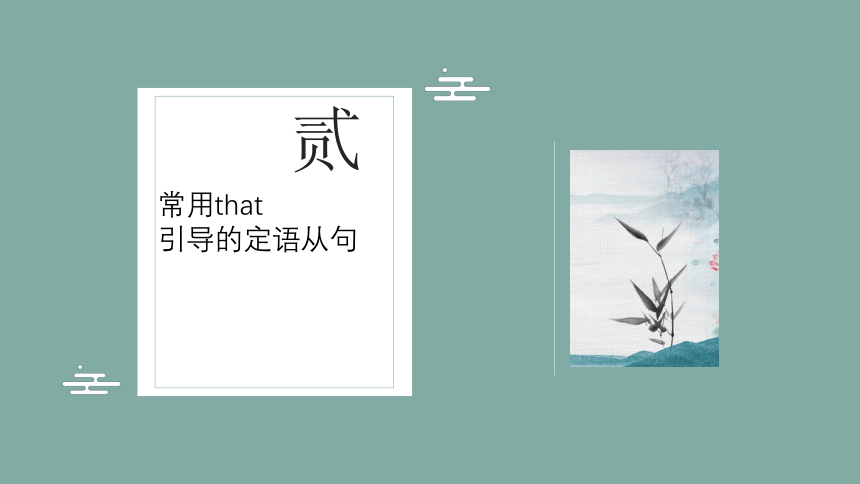

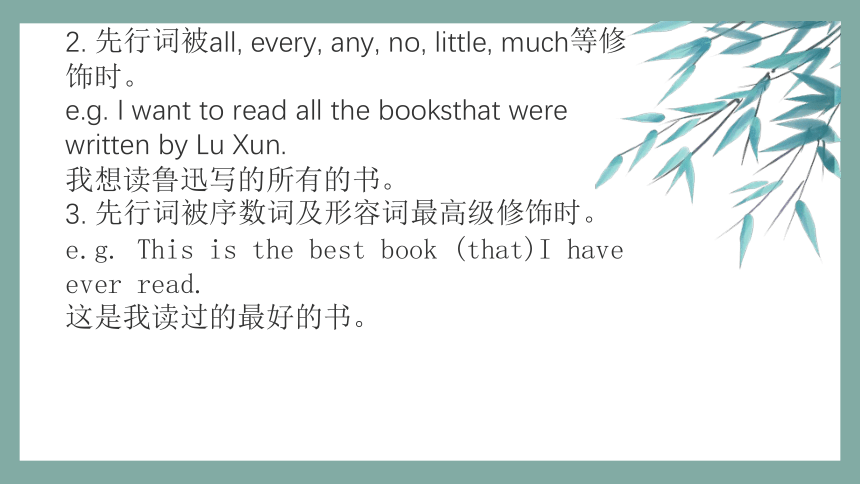
文档简介
(共21张PPT)
九
年
级
下册
Unit
5
语法
知识结构
Unit
5
语法
壹.先行词为人的定语从句
贰.常用that引导的定语从句
叁.做宾语和定语的关系代词
肆.连词
壹
who与that,whom,whose
1.
who指人,that也可指人,在从句中作主语或宾语。作主语时不能省略,作宾语时可省略。e.g.
The
teacher
who
spoke
at
themeeting
just
now
is
having
a
rest
in
his
office.刚才在会上讲话的老师正在他办公室里休息。(作主语,不可省略)
2.
whom指人,为who的宾格形式,在句中只能作宾语。
其前没有介词时,也可用who/that代替,也可省略。e.g.
The
girl
(who/whom/that)
I
like
isn’t
here
now.我喜欢的那个女孩现在没在这儿。(作宾语,可省略)The
doctor
with
whom
she
went
to
the
United
States
lastmonth
is
very
famous.上月与她同去美国的那位医生非常有名。(作介词宾语,介词with提到了whom前,whom在此不能省略,也不能用who代替)
3.
whose指人,也可指物,在从句中作定语,不可省略。e.g.
The
girl
whose
father
is
a
doctor
is
our
classmate.父亲是医生的那个女孩是我们的同学。(作定语,不能省略)
贰
常用that
引导的定语从句
常用that引导的定语从句:1.
先行词是不定代词all,
everything,
nothing,
anything,
much,little,
few等时。e.g.
Is
there
anything
(that)
youdon’t
understand?你还有不懂的地方吗?
2.
先行词被all,
every,
any,
no,
little,
much等修饰时。e.g.
I
want
to
read
all
the
booksthat
were
written
by
Lu
Xun.
我想读鲁迅写的所有的书。3.
先行词被序数词及形容词最高级修饰时。e.g.
This
is
the
best
book
(that)I
have
ever
read.这是我读过的最好的书。
4.
先行词被the
only,
the
very,
the
last,
the
same修饰时。(当先行词是人时,也可用关系代词who,
whom)e.g.
He
is
the
only
personthat/who
can
help
you
out.他是唯一一个能帮你摆脱困境的人。5.
当有两个或两个以上分别表示人或物的先行词时。e.g.
We
are
talking
about
thepeople
and
the
things
(that)
we
have
visited
in
this
country.我们正在谈论在这个国家所见过的人和事。
6.
关系代词作定语从句中be的表语时,
that通常省略。e.g.
The
city
is
no
longer
theone
(that)
it
used
to
be.这个城市不再是原来的样子了。7.
主句是以who,
what,
which开头的特殊问句时。e.g.
Who
is
the
person
that
is
making
this
lecture?是谁在做报告?注:关系代词前有介词时只用which,不能用that。
作宾语和定语的关系代词
叁
做宾语和定语
的关系代词
作宾语和定语的关系代词
1.whom指人,为who的宾格形式,在句中只能作宾语。其前没有介词时,也可用who/that代替,也可省略。
e.g.The
girl
(who/whom/that)
I
like
isn’t
here
now.
我喜欢的那个女孩现在没在这儿。(作宾语,可省略)
Thedoctor
with
whom
she
went
to
the
United
States
last
month
is
very
famous.
上月与她同去美国的那位医生非常有名。
(作介词宾语,介词with提到了whom前,whom在此不能省略,也不能用who代替)
2.which与that指物,在句中作宾语,可以省略。
e.g.I
like
the
book
which/that
my
mother
bought
for
me
yesterday.
我喜欢妈妈昨天给我买的那本书。(作宾语,可以省略)
3.whose指人,也可指物,在从句中作定语,不可省略。
e.g.
The
girl
whose
father
is
a
doctor
is
ourclassmate.
父亲是医生的那个女孩是我们的同学。(作定语,不能省略)
肆
连词
1.
both
...
and
...
意为“两者都;既……又……;不仅……而且……”。
(1)连接主语,谓语用复数形式。
e.g.
Both
Kangkang
and
Susanna
are
in
that
school.
??????康康和苏珊娜都在那所学校。
(2)连接谓语。
e.g.
I
can
bothspeak
and
write
English.
??????我既会说英语又会写英语。
注意:both
...
and
...?的否定用neither
...
nor
...
e.g.
He
can
speak
both
English
and
French.
他既会说英语又会说法语。
否定:He
can
speak
neither
English
nor
French.
他既不会说英语也不会说法语。
2.
neither
...
nor...?意为“两者都不;既不……也不……”。
(1)连接主语,谓语动词与邻近的主语单复数保持一致。
e.g.
Neither
he
nor
I
am
from
China.
??????他和我都不是中国人。
(2)连接谓语。
e.g.
I
neither
likeplaying
computer
games
nor
like
watching
TV.
我既不喜欢玩电脑游戏也不喜欢看电视。
3.?either
...
or...
意为“或……或……;是……还是……;不是……就是……”。
(1)连接主语,谓语动词与邻近的主语单复数保持一致。
e.g.
Either
you
or
he
goes
to
school
by
bike.
??????或者是你或者是他骑车去上学。
(2)连接谓语。
e.g.
You
can
eithergo
to
school
or
stay
at
home.
??????你要么去上学,要么待在家里。
4.?not
only
...
but
also
...意为“不但……而且……”。
(1)连接主语,谓语动词与邻近的主语单复数保持一致。
e.g.?Not
only
you
butalso
he
speaks
Japanese
in
our
class.
??????我们班不仅你说日语,而且他也说日语。
(2)连接谓语。
e.g.?Tom
not
only
speaks
English
but
also
speaks
Japanese?at
school.?
汤姆在学校不仅说英语而且还讲日语。
本节内容回顾
Unit
5
语法
壹.先行词为人的定语从句
贰.常用that引导的定语从句
叁.做宾语和定语的关系代词
肆.连词
Thank
you!
九
年
级
下册
Unit
5
语法
知识结构
Unit
5
语法
壹.先行词为人的定语从句
贰.常用that引导的定语从句
叁.做宾语和定语的关系代词
肆.连词
壹
who与that,whom,whose
1.
who指人,that也可指人,在从句中作主语或宾语。作主语时不能省略,作宾语时可省略。e.g.
The
teacher
who
spoke
at
themeeting
just
now
is
having
a
rest
in
his
office.刚才在会上讲话的老师正在他办公室里休息。(作主语,不可省略)
2.
whom指人,为who的宾格形式,在句中只能作宾语。
其前没有介词时,也可用who/that代替,也可省略。e.g.
The
girl
(who/whom/that)
I
like
isn’t
here
now.我喜欢的那个女孩现在没在这儿。(作宾语,可省略)The
doctor
with
whom
she
went
to
the
United
States
lastmonth
is
very
famous.上月与她同去美国的那位医生非常有名。(作介词宾语,介词with提到了whom前,whom在此不能省略,也不能用who代替)
3.
whose指人,也可指物,在从句中作定语,不可省略。e.g.
The
girl
whose
father
is
a
doctor
is
our
classmate.父亲是医生的那个女孩是我们的同学。(作定语,不能省略)
贰
常用that
引导的定语从句
常用that引导的定语从句:1.
先行词是不定代词all,
everything,
nothing,
anything,
much,little,
few等时。e.g.
Is
there
anything
(that)
youdon’t
understand?你还有不懂的地方吗?
2.
先行词被all,
every,
any,
no,
little,
much等修饰时。e.g.
I
want
to
read
all
the
booksthat
were
written
by
Lu
Xun.
我想读鲁迅写的所有的书。3.
先行词被序数词及形容词最高级修饰时。e.g.
This
is
the
best
book
(that)I
have
ever
read.这是我读过的最好的书。
4.
先行词被the
only,
the
very,
the
last,
the
same修饰时。(当先行词是人时,也可用关系代词who,
whom)e.g.
He
is
the
only
personthat/who
can
help
you
out.他是唯一一个能帮你摆脱困境的人。5.
当有两个或两个以上分别表示人或物的先行词时。e.g.
We
are
talking
about
thepeople
and
the
things
(that)
we
have
visited
in
this
country.我们正在谈论在这个国家所见过的人和事。
6.
关系代词作定语从句中be的表语时,
that通常省略。e.g.
The
city
is
no
longer
theone
(that)
it
used
to
be.这个城市不再是原来的样子了。7.
主句是以who,
what,
which开头的特殊问句时。e.g.
Who
is
the
person
that
is
making
this
lecture?是谁在做报告?注:关系代词前有介词时只用which,不能用that。
作宾语和定语的关系代词
叁
做宾语和定语
的关系代词
作宾语和定语的关系代词
1.whom指人,为who的宾格形式,在句中只能作宾语。其前没有介词时,也可用who/that代替,也可省略。
e.g.The
girl
(who/whom/that)
I
like
isn’t
here
now.
我喜欢的那个女孩现在没在这儿。(作宾语,可省略)
Thedoctor
with
whom
she
went
to
the
United
States
last
month
is
very
famous.
上月与她同去美国的那位医生非常有名。
(作介词宾语,介词with提到了whom前,whom在此不能省略,也不能用who代替)
2.which与that指物,在句中作宾语,可以省略。
e.g.I
like
the
book
which/that
my
mother
bought
for
me
yesterday.
我喜欢妈妈昨天给我买的那本书。(作宾语,可以省略)
3.whose指人,也可指物,在从句中作定语,不可省略。
e.g.
The
girl
whose
father
is
a
doctor
is
ourclassmate.
父亲是医生的那个女孩是我们的同学。(作定语,不能省略)
肆
连词
1.
both
...
and
...
意为“两者都;既……又……;不仅……而且……”。
(1)连接主语,谓语用复数形式。
e.g.
Both
Kangkang
and
Susanna
are
in
that
school.
??????康康和苏珊娜都在那所学校。
(2)连接谓语。
e.g.
I
can
bothspeak
and
write
English.
??????我既会说英语又会写英语。
注意:both
...
and
...?的否定用neither
...
nor
...
e.g.
He
can
speak
both
English
and
French.
他既会说英语又会说法语。
否定:He
can
speak
neither
English
nor
French.
他既不会说英语也不会说法语。
2.
neither
...
nor...?意为“两者都不;既不……也不……”。
(1)连接主语,谓语动词与邻近的主语单复数保持一致。
e.g.
Neither
he
nor
I
am
from
China.
??????他和我都不是中国人。
(2)连接谓语。
e.g.
I
neither
likeplaying
computer
games
nor
like
watching
TV.
我既不喜欢玩电脑游戏也不喜欢看电视。
3.?either
...
or...
意为“或……或……;是……还是……;不是……就是……”。
(1)连接主语,谓语动词与邻近的主语单复数保持一致。
e.g.
Either
you
or
he
goes
to
school
by
bike.
??????或者是你或者是他骑车去上学。
(2)连接谓语。
e.g.
You
can
eithergo
to
school
or
stay
at
home.
??????你要么去上学,要么待在家里。
4.?not
only
...
but
also
...意为“不但……而且……”。
(1)连接主语,谓语动词与邻近的主语单复数保持一致。
e.g.?Not
only
you
butalso
he
speaks
Japanese
in
our
class.
??????我们班不仅你说日语,而且他也说日语。
(2)连接谓语。
e.g.?Tom
not
only
speaks
English
but
also
speaks
Japanese?at
school.?
汤姆在学校不仅说英语而且还讲日语。
本节内容回顾
Unit
5
语法
壹.先行词为人的定语从句
贰.常用that引导的定语从句
叁.做宾语和定语的关系代词
肆.连词
Thank
you!
同课章节目录
- Unit 5 China and the world
- Topic 1 China attracts millions of tourists from a
- Topic 2 He is really the pride of China.
- Topic 3 Now it is a symbol of England.
- Unit 6 Entertainment and Friendship.
- Topic 1 I would rather watch sports shows than tho
- Topic 2 Who is your favorite character in literatu
- Topic 3 I will remember our friendship forever.
